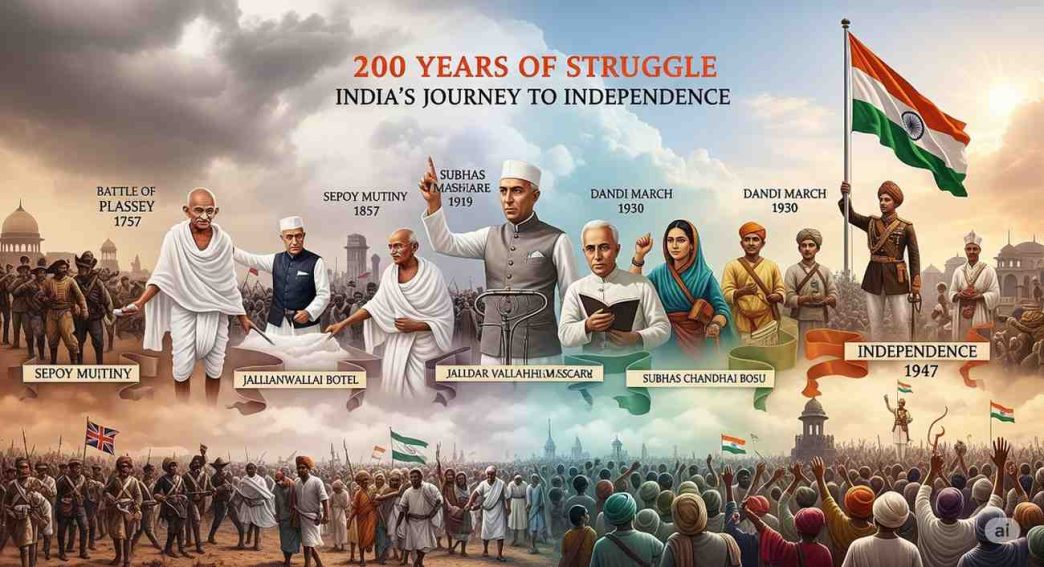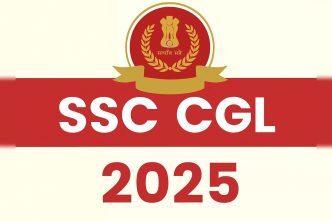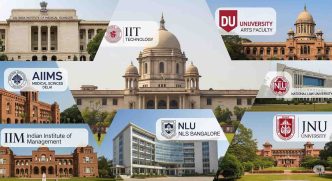Explore India’s 200 years of struggle for independence — a powerful journey of resistance, sacrifice, and unity that led to the nation’s freedom in 1947.
Introduction
India’s independence was not a gift. It was earned through 200 years of struggle, sacrifice, resilience, and courage. From the fall of kingdoms to the rise of national awakening, the road to freedom was long and painful. The British colonial rule, which began in the 18th century, gripped the Indian subcontinent in economic exploitation, political manipulation, and social injustice. But against this darkness, rose a light — the undying will of the Indian people.
This is the story of a nation that never gave up. A story of 200 years of struggle that finally led to the birth of the largest democracy in the world.
The Origins of Colonial Rule
The story began with trade. The East India Company, which came to India for commerce, gradually took over territories using deceit and force. The Battle of Plassey in 1757 marked the beginning of British political power. Over time, they dismantled local leadership, imposed heavy taxes on farmers, and looted India’s natural wealth.
This led to early revolts and dissatisfaction — the seeds of the 200 years of struggle were sown.
1857: The First Major Uprising
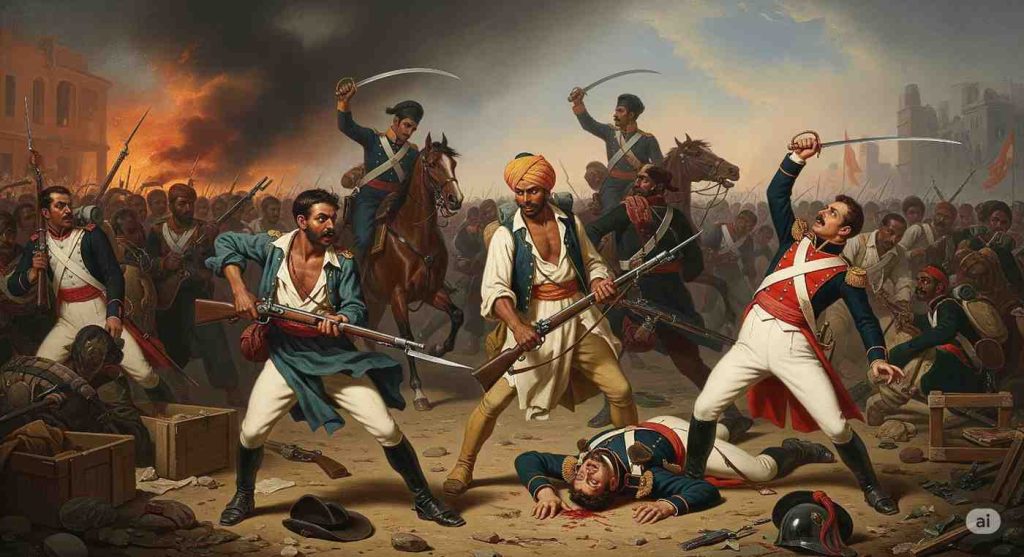
The first major flashpoint in this 200 years of struggle came with the Revolt of 1857, often called the First War of Independence. It was not just a sepoy mutiny — it was a collective resistance involving soldiers, peasants, and kings like Rani Lakshmibai, Bahadur Shah Zafar, and Tantia Tope.
Although it was eventually suppressed, it shattered the myth of British invincibility and ignited a national consciousness that would continue to grow.
Rise of Political Awareness
By the late 19th century, India saw a wave of educated leaders who believed change could come through dialogue and political reform. The Indian National Congress (INC) was formed in 1885. Leaders like Dadabhai Naoroji, Gopal Krishna Gokhale, and Bal Gangadhar Tilak began voicing Indian concerns on a national platform.
This period in the 200 years of struggle was marked by petitions, public meetings, and debates — a peaceful beginning that would soon evolve into mass movements.
The Revolutionaries: Fire and Freedom

While some followed peaceful methods, others believed only armed resistance could free the nation. Brave revolutionaries like Bhagat Singh, Chandrashekhar Azad, and Rajguru struck fear into the British Empire with their fearless actions.
They were young, determined, and willing to die for the nation. Their sacrifices added fire to the 200 years of struggle, reminding Indians that freedom often demands the highest price.
The Silent Force: Gandhiji’s Way to Independence
When India’s 200 years of struggle needed direction, Gandhiji stepped in — not with weapons, but with truth.
He believed non-violence was not weakness, but the highest form of strength.
Through movements like the Salt March and Quit India, he awakened the masses.
Millions followed him — not with swords, but with silent courage.
His method of Satyagraha made the freedom struggle a moral battle.
The British had guns, but Gandhi had people — united, peaceful, and unshaken.
His quiet resolve became the loudest roar of resistance.
He didn’t just fight for freedom — he redefined how to win it.
That was the silent force that shook an empire.
World Wars and the Shifting Balance
World War I and II had a significant impact on India’s freedom struggle. The British needed Indian resources and soldiers, which further strained their rule. Meanwhile, leaders like Subhas Chandra Bose chose a different path by creating the Indian National Army (INA) and seeking foreign support to liberate India militarily.
Even though not all strategies aligned, this diversity of approaches during the 200 years of struggle showed how deeply India desired its freedom.
15th August 1947: A Nation is Born
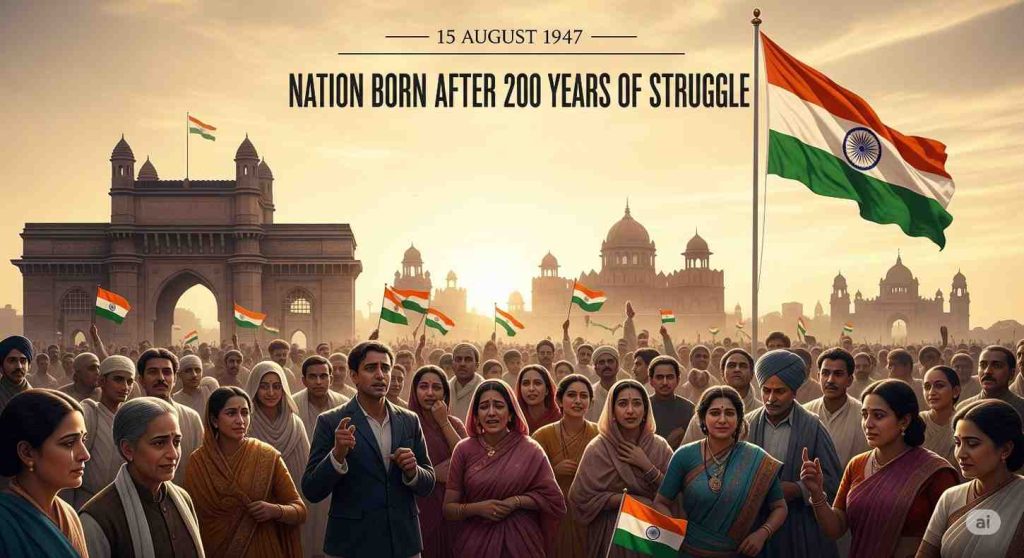
After centuries of oppression and resistance, India finally achieved its independence on 15th August 1947. The moment was historic, emotional, and unforgettable. But it also came with the trauma of Partition, which divided India and Pakistan, displacing millions and causing mass violence.
Still, the goal of the 200 years of struggle was achieved — India was finally free.
The Legacy of 200 Years of Struggle
The legacy of this 200 years of struggle is not just about the past. It’s a reminder of the strength, unity, and courage that define India. The freedom we enjoy today — to speak, vote, learn, protest, and dream — was built on the sacrifices of those who came before us.
From farmers to students, poets to soldiers, women to revolutionaries — every Indian contributed in some way. Their collective voice and actions shaped a new destiny for the nation.
Unwritten Histories: The People Behind the Struggle
Not every hero of the 200 years of struggle made it into history books.
Many lived and died in silence, yet their courage shaped India’s freedom.
They were farmers who refused taxes, women who marched fearlessly,
and children who acted as silent messengers under British noses.
Mothers blessed their sons heading to prison.
Poets ignited rebellion with verses whispered in secret.
Shopkeepers passed messages in goods, teachers taught forbidden truths.
They had no podiums, no headlines — but they held the movement together.
Without their sacrifice, the struggle could not have survived.
These are the unwritten histories, the foundation of freedom.
Let us not forget: India was freed not only by leaders, but by its people.
The nameless millions were the true soul of the Indian freedom struggle.
FAQs on India’s 200 Years of Struggle for Independence
1. What does “200 years of struggle” refer to in Indian history?
The phrase “200 years of struggle” refers to India’s long and difficult fight against British colonial rule, which began around the mid-18th century with the Battle of Plassey in 1757 and ended with independence in 1947. It marks a continuous journey of resistance, sacrifice, and national awakening.
2. Why did India’s struggle for freedom last 200 years?
India’s 200 years of struggle was prolonged due to multiple factors — including British military dominance, India’s internal divisions, and early lack of national unity. Over time, political awakening, mass movements, and public participation turned the tide in favor of freedom.
3. Who were some key figures in the 200 years of struggle?
Several great leaders shaped the 200 years of struggle, including Mahatma Gandhi, Subhas Chandra Bose, Bhagat Singh, Rani Lakshmibai, and Jawaharlal Nehru. Alongside them, countless unnamed heroes — villagers, women, students — played equally powerful roles.
4. What were the major events during the 200 years of struggle?
Key events during the 200 years of struggle include the Revolt of 1857, Formation of Indian National Congress (1885), Non-Cooperation Movement (1920), Salt March (1930), Quit India Movement (1942), and finally, Independence in 1947.
5. How is the 200 years of struggle remembered today?
Today, the 200 years of struggle is remembered through Independence Day celebrations, Republic Day parades, school programs, museums, films, and historical literature. It remains a powerful symbol of India’s unity, resilience, and patriotic legacy.
Conclusion: Responsibility with Freedom
The 200 years of struggle teaches us that freedom is never free. It is earned — and must be protected. As citizens of independent India, we hold the responsibility to preserve democracy, ensure justice, and uplift those still suffering from inequality.
Let us use our freedom wisely. Let us not forget the lessons written in sacrifice, struggle, and resilience. Let the spirit of 200 years of struggle guide our future. 🇮🇳 Jai Hind. Vande Mataram.

